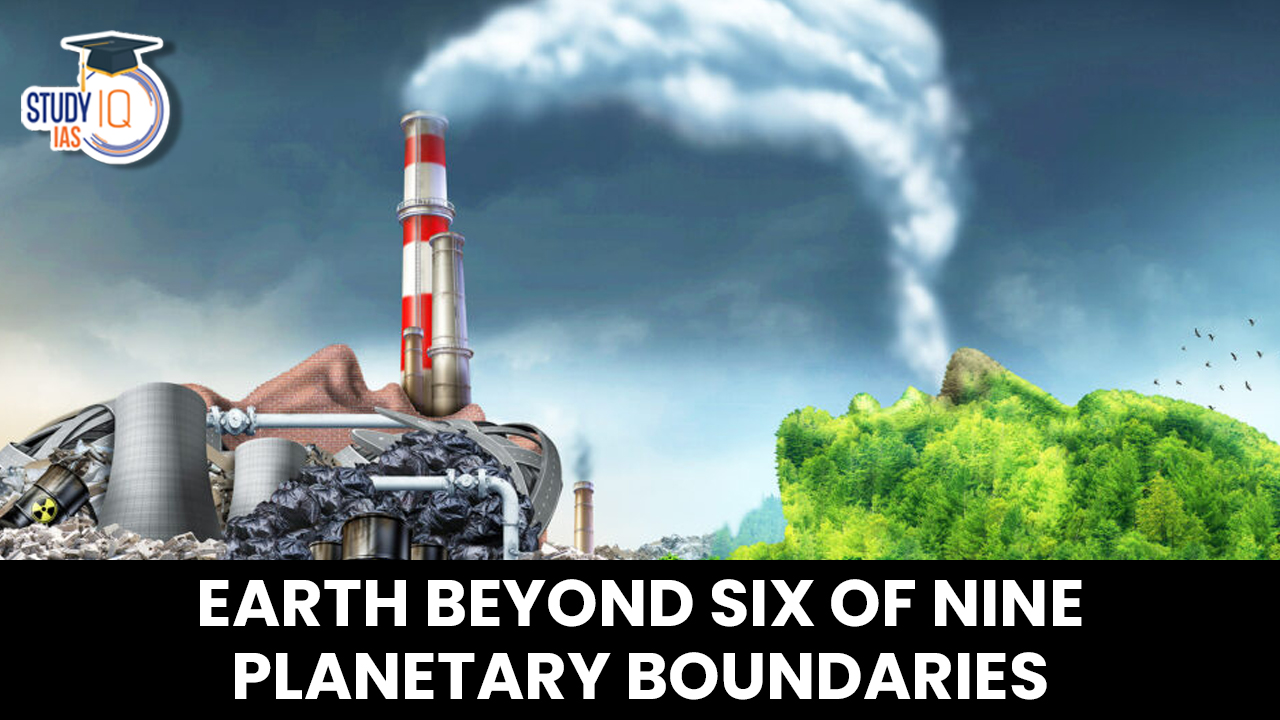Table of Contents
Context: According to a new study published in the journal Science Advances, six out of the nine planetary boundaries have been breached due to human-induced pollution and the destruction of the natural world.
What are Planetary Boundaries?
- Planetary boundaries are like a set of environmental thresholds that, if crossed, could lead to abrupt and irreversible changes, posing significant risks to human societies and the stability of the planet.
- The planetary boundaries framework was first proposed in 2009 by a group of international scientists, led by Johan Rockström.
- They identified nine planetary boundaries, which they defined as “planetary-scale environmental processes that control the stability and resilience of the Earth system.”
- The nine planetary boundaries include the following:
- Biosphere integrity: The health of ecosystems and rate of extinction of species.
- Climate change: Atmospheric CO2 concentration and the change in radiative forcing.
- Novel entities: Levels of plastic, concrete, synthetic chemicals, gene-modified organisms, etc.
- Stratospheric ozone depletion: The anthropogenic release of manufactured chemicals that destroy ozone molecules.
- Freshwater change: It includes an examination of the human-induced impact on blue water (found in lakes, rivers, and reservoirs) and green water (available in the soil for plants and soil microorganisms).
- Atmospheric aerosol loading: Tracking various particles from anthropogenic emissions that affect cloud formation as well as global and regional atmospheric circulation.
- Ocean acidification: Reduction in the pH of the ocean over an extended period of time.
- Land system change: Changes in land use, especially the conversion of tropical forests to farmland.
- Biogeochemical flow: Alteration in the natural flows and the forms of nitrogen and phosphorus cycles, which are essential elements for plant growth.

Key Findings of the Study
- Out of the nine planetary boundaries, humans have breached six: climate change, biosphere integrity, freshwater change, land system change, biogeochemical flows and novel entities.
- While atmospheric aerosol loading and ozone depletion remain within the constraints, ocean acidification is close to being breached.
- Impacted Boundaries:
- Climate Change: The researchers set the planetary boundary for atmospheric carbon dioxide concentration and radiative forcing (represents the size of the energy imbalance in the atmosphere) contributing to climate change at 350 parts per million (ppm) and 1 Watts per square meter (Wm−2), respectively. Currently, this has reached 417 ppm and is 2.91 W m−2.
- Biosphere Integrity: As for biosphere integrity, the researchers kept a limit of less than 10 extinctions per million species-years. The study estimated the extinction rate was greater than 100 extinctions per million species-years.
- Land System Change: The global forested land area has dropped below the safe limit of 75%, currently standing at only 60%.
- Freshwater Change: Both blue water (surface and groundwater) and green water (available water for plants) have experienced impacts beyond their safe thresholds of 10.2% and 11.1%, respectively in 1905 and 1929, currently at 18.2 % and 15.8 %, respectively.
- Biogeochemical Flows: Flows of nutrients like phosphorus and nitrogen in the environment have surged beyond safe limits. The boundary was fixed at 11 teragrams (Tg) for Phosphorus and 62 Tg for Nitrogen. This is now 22.6 Tg and 190 Tg, respectively.
- Novel Entities: The planetary boundary of novel entities was calculated to be zero. Human influence on novel entities, including microplastics, endocrine disruptors, and organic pollutants, has transgressed the zero boundary.
Way Forward
- Utilize Planetary Boundaries as a Global Framework: Encourage global organizations like the UN Security Council, G7, G20, and governments to use the framework for global coordination.
- Accountability and Commitment: Ensure accountability to existing agreements such as the High Seas Treaty, Paris Agreement, and Global Biodiversity Agreement while committing to keeping all nine Planetary Boundaries within safe limits.
- Invest in Planetary Science and Solutions: Increase investment in research and solutions to address the six breached boundaries and prevent further damage to Earth’s systems.
- Reform International Financial Architecture: Restructure financial systems to consider the value of nature, increase funding for adaptation, mitigation, and development, and avoid burdening emerging economies with debt.
- Set Science-Based Targets: Develop science-based targets for all nine boundaries and encourage businesses and governments to disclose their environmental impacts.
- Legal Reforms: Reform legal structures to prioritize issues such as ecocide, Indigenous rights, and intergenerational rights, recognizing humanity’s dependence on nature for survival.


 Daily Quiz 05 July 2025
Daily Quiz 05 July 2025
 SSC MTS Apply Online for 1075 Posts – ...
SSC MTS Apply Online for 1075 Posts – ...
 Dynamic Pricing: What It Is and Why It's...
Dynamic Pricing: What It Is and Why It's...





















